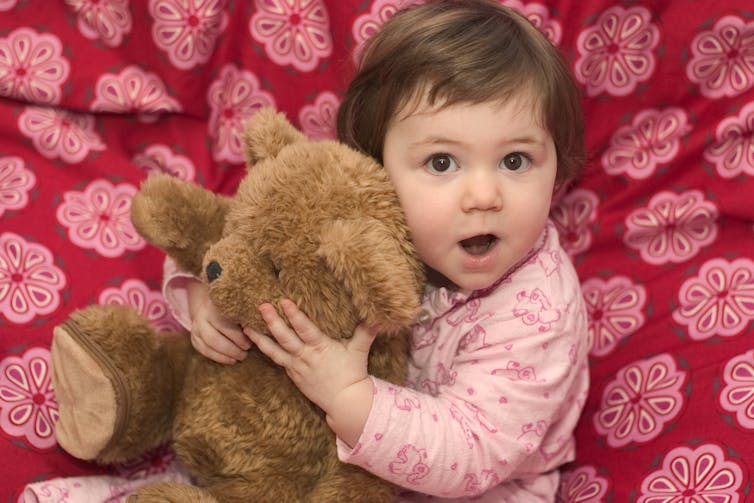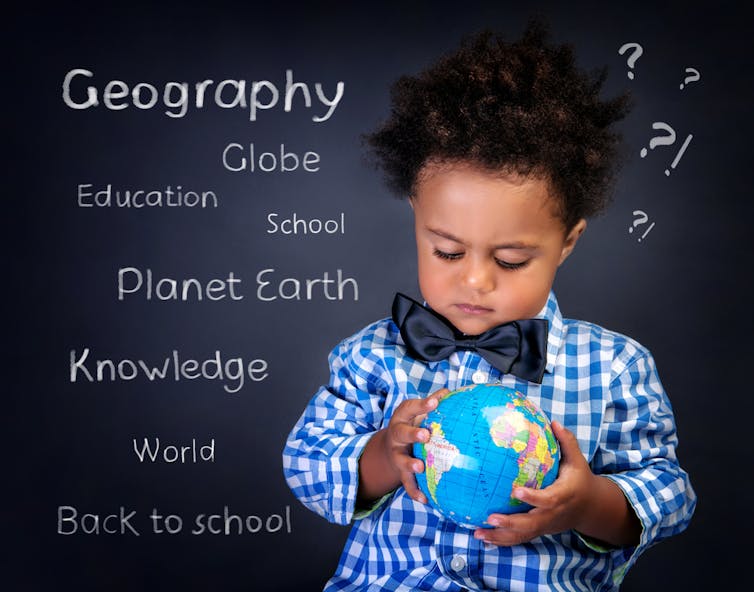Baby Looks at Self in Mirror Baby Looks at Self in Mirror Mime
From the moment they are born, babies are exposed to information that can teach them near who they are. By touching their own face up and body, or past kicking and grabbing things, they start to enjoy the influence of their actions on the world. But it is not until children arroyo their second altogether that they get-go to develop a sense of self and are able to reflect on themselves from the perspective of somebody else.
One indication of this new objective self-awareness is that children showtime recognising themselves in a mirror or photo – something most children do by the age of two. This kind of cocky-awareness tin be assessed scientifically by surreptitiously putting a small mark on a kid's forehead, such as by kissing them while wearing lipstick. The kid can't experience the mark so their sense of touch can't alert them to its presence – simply they tin can encounter information technology if they look in a mirror. If the child has the capacity to see themselves as some other person would, they will reach up to bear upon the mark when shown a mirror, indicating that they equate the mirror paradigm with their ain body.
Finding the concept of the 'cocky'
Toddlers likewise naturally demonstrate their self-awareness past their ability to use and understand self-referential language such as I, me, yous and my. Another example is when they claim something as their own property – the cry of "it'southward mine" is the origin of many sibling disputes.
The appearance of self-conscious emotions such as embarrassment, pride, guilt and shame also demonstrates that a kid is developing self-consciousness. Parents may find that past the time they are iii-years-old, their child is motivated to make amends for wrongdoing, can be proud of their own behaviour, or hides when unhappy about something they have done.

Toddlers' power to think about themselves from the perspective of a second person also marks the beginning of their conquering of what's called "self-concept" – stable thoughts and feelings near the self. Between their first and second birthdays, children volition be able to produce unproblematic cocky-descriptions and evaluations such every bit "I am a expert boy", which will become more complex over fourth dimension. Past the fourth dimension a kid is effectually 8-years-old, they will have a relatively stable idea of their own personality traits and dispositions, and whether they feel like a valuable and competent person.
Individual differences in personality and feelings of self-worth can influence a child's approach to social situations and academic achievement. Children with positive perceptions of themselves have the best social and academic outcomes, perhaps because they focus on success and aren't deterred by failure. Parents tin assistance their child develop positive self-esteem by reacting positively to them and their achievements, and helping them to overcome negative events.
Psychologists recall parents can besides shape children'due south self-worth right from birth: when they provide a positive response to an infant's actions it provides them with their commencement experiences of having a positive impact on the globe.
Influences on memory and learning
Regardless of how children experience about themselves, adding an "idea of me" to their cognitive architecture changes the mode they process data. For case, as adults, we remember very few childhood events. One intuitive explanation for this "babyhood amnesia" is that until memories can be related to our sense of self, they are very difficult to store and remember.
Once a child's sense of self is established, they are more likely to recall information that is related to themselves. This is known every bit the "self-reference effect" on memory and emerges early on. From at least iii-years-sometime children are more likely to remember objects linked with themselves than those linked with another person.
For example, in 1 experiment, children betwixt four and six-years-erstwhile were asked to sort pictures of shopping items into their own basket, and a shopping basket owned past some other person. Later the items were sorted, the children were shown a wider option of shopping items and asked which ones they recognised from the previous game. Children accurately remembered more of the items that they "endemic", than items that had been sorted into the other person's basket.
The self-reference outcome occurs considering items linked with the self – such as "my apple" – attract additional attending and memory support inside the brain, ensuring that information of potential use to the self is non lost.

The self reference outcome can be used to help children procedure and learn data, especially equally it emerges early in life. And so request children to retrieve well-nigh themselves while generating sentences to practice their spelling – such as sentences beginning with the word "I" – can significantly improve their subsequent spelling functioning. Putting maths bug in the first-person – for case: "you have four apples more than Tom" – besides improves both the speed and accuracy of children's responses.
In summary, selfhood starts at birth, but children don't offset expressing an "idea of me" until toddlerhood. Children then beginning to gather information about themselves and store autobiographical material, starting a life narrative that guides their responses to the globe.
Source: https://theconversation.com/how-do-children-develop-a-sense-of-self-56118
0 Response to "Baby Looks at Self in Mirror Baby Looks at Self in Mirror Mime"
Post a Comment